🍼🍼 Why Toys Matter from Day One
Choosing the right sensory toys for infants is one of the most important things you can do in the first six months of your baby’s life. These toys play a big role in brain growth, emotional bonding, and sensory discovery — right from day one.
Do you remember your baby’s very first toy?
it may be a soft teddy bear, a soothing rattle toy, or a pair of black and white cards with high contrast colors.These may seem like simple objects at first glance — but for your newborn, they are the gateway to learning, bonding, and brain development.
From the very first weeks of life, babies begin absorbing information from their environment. Even before they can hold a toy, they observe, listen, and feel — and every sight, sound, and touch helps shape the architecture of the brain. This is not just poetic; it’s proven science.
Harvard Center on the Developing Child, says that the first few years of life, the brain makes more than millions new links between neurons. These early years — especially the first six months — are a critical window for healthy development. It’s during this stage that the foundation for lifelong learning, behavior, and emotional health is built,in brief you must introduce toys or sensory toys for infants from day one.
That’s exactly where toys come in.
Sensory toys for infants not just playthings. The right toys act as tools for discovery — allowing your baby to engage their senses, learn to control their body, recognize sounds, bond emotionally, and begin to understand their surroundings. For example, a simple black-and-white card helps your baby’s eyes focus and track, while a soft rattle introduces rhythm, sound, and cause-and-effect learning.
Toys also foster emotional security. That favorite soft plush toy isn’t just cute — it’s a comforting companion that helps babies manage their emotions, especially when parents are not in immediate sight.
This blog will guide you through everything you need to know about toys for babies aged 0 to 6 months. Whether you’re a first-time parent or looking to upgrade your toy basket, this article will help you:
✅ Discover Why Toys Are More Than Just “Play”
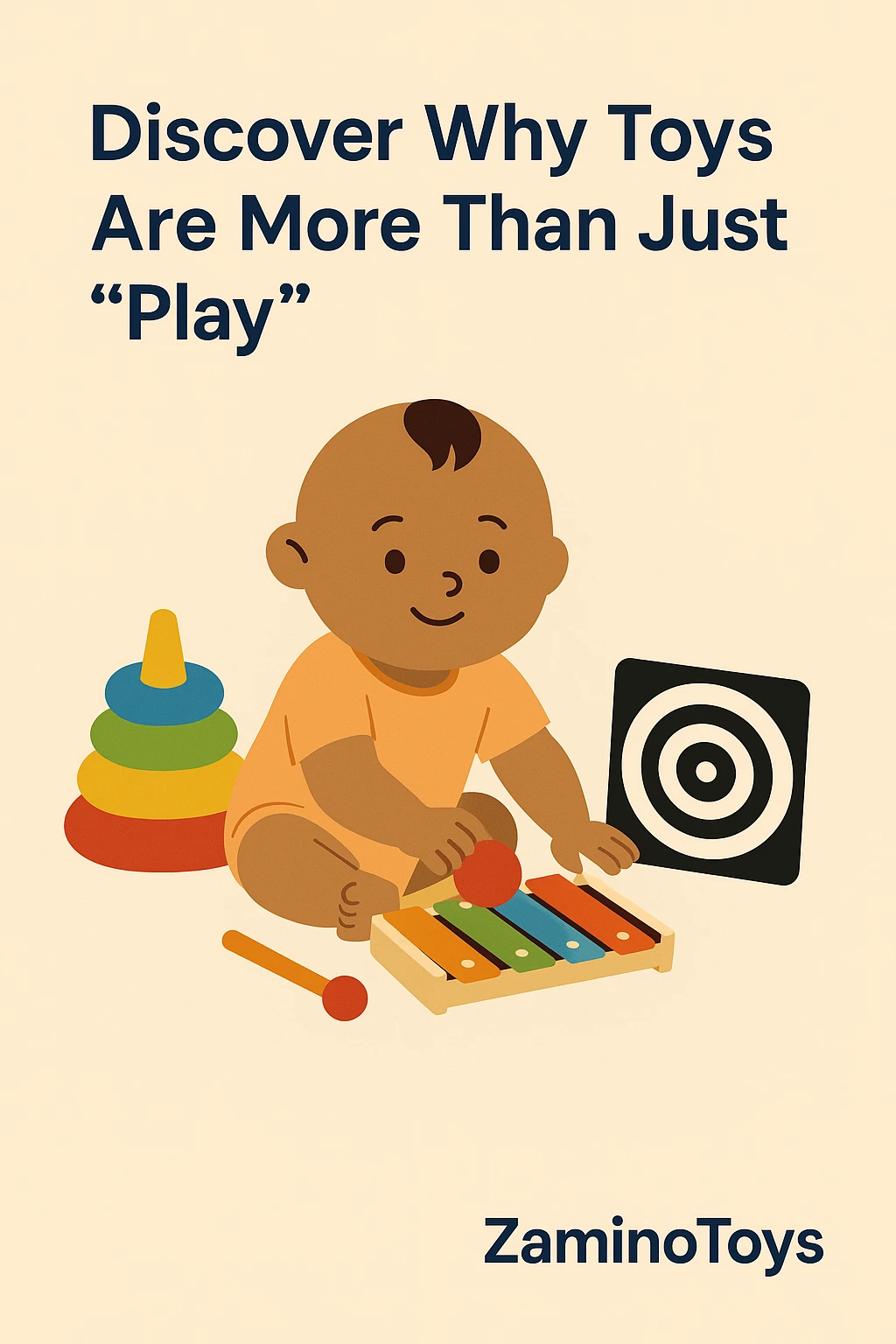
Toys support early learning in ways that go far beyond entertainment. They teach babies to observe, react, and remember, forming the earliest building blocks of intelligence.
✅ Learn About the Best Sensory Toys for Infants
From black-and-white visuals to soft-textured rattles and musical mobiles — we’ll show you which toys are ideal for stimulating all five senses at every stage.
✅ Understand How Toys Support Brain Growth, Motor Skills, and Emotional Bonding
Playtime is a combination of education and emotional connection. We’ll explain how toys impact gross motor development, brain structure, and bonding with caregivers.
✅ Choose the Right Toy for Every Stage – 0–3 Months and 3–6 Months
Babies grow incredibly fast, and their needs change every few weeks. Learn how to adapt your toy selection to support each milestone.
✅ Recognize Which Toys Are Safe and Suitable
Not all toys are baby-safe. Learn what to avoid and how to choose BIS or EN71-certified toys that are safe for teething, mouthing, and soft cuddling.
✅ Shop Smart Without Overloading
You don’t need dozens of toys. We’ll help you pick 5–7 must-have toys that offer the most benefit for your baby’s age and needs.
So, let’s explore the soft, colorful, musical, and sensory-rich world of toys for newborns — where every squeak, crinkle, and cuddle has a purpose. You’ll soon realize that the toys you choose today are helping build the mind of tomorrow.
🔗 Related Blog: Toys – What, When & Why? A Complete Guide for Parents
The First 6 Months of Life – What’s Happening?
Your baby goes through a lot of changes From birth to six months. They go from a sleepy, reflex-driven newborn to a smiling, curious explorer. This is also when their brain builds more than 1 million connections every second.
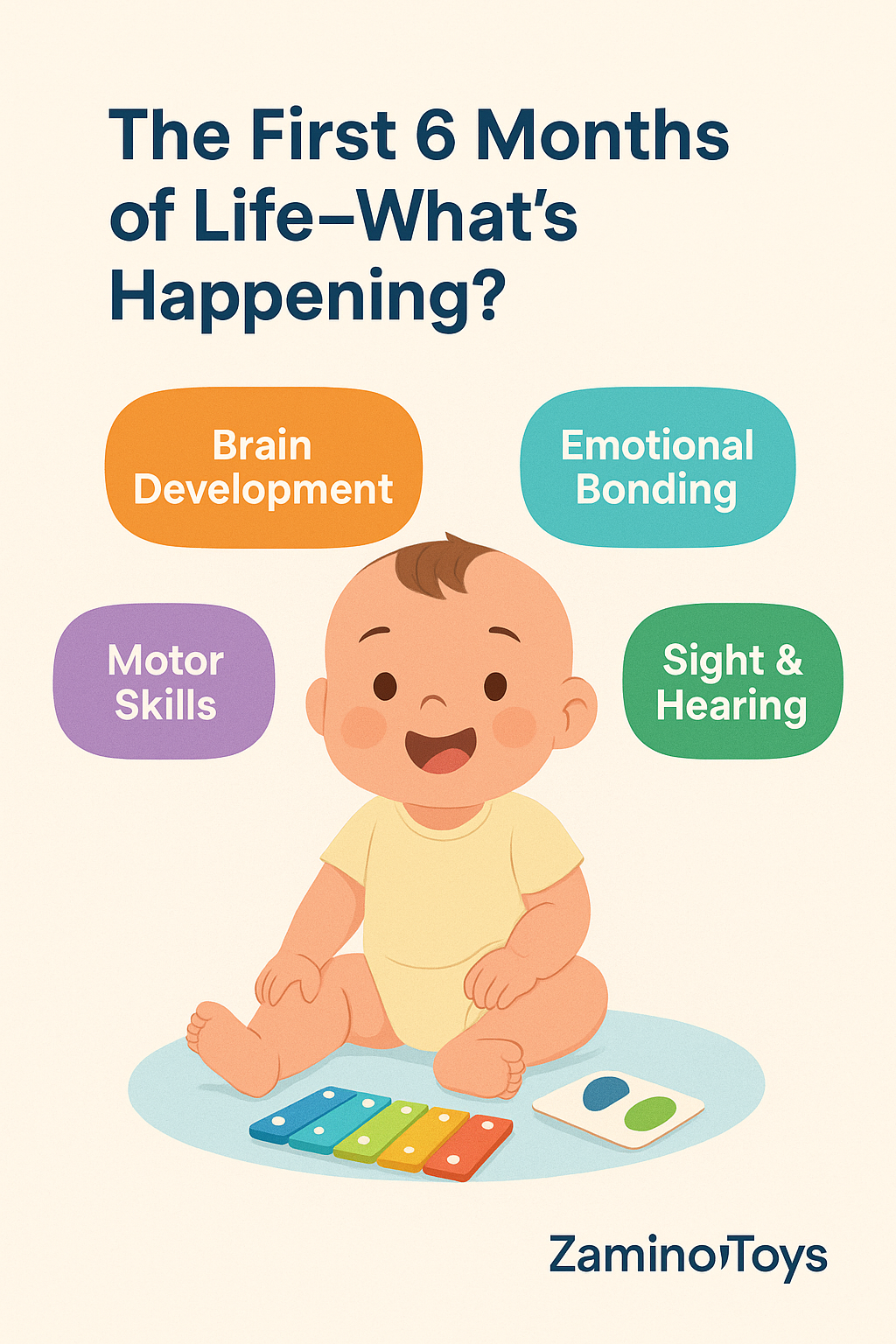
Let’s look at the growth milestones:
| Age Range | Key Developments |
| 0–3 Months | Visual tracking, sound recognition, grasp reflex, early bonding |
| 3–6 Months | Smiling, babbling, rolling, grabbing, teething, self-recognition |
Toys that align with each stage support this natural development.
0–3 Months – Gentle Beginnings
At this stage, your baby can see only 8–12 inches ahead, hears muffled sounds, and responds mainly to touch and light. Toys should stimulate senses gently, without overwhelming them.
🎯 What Should Toys Do?
- Improve eye focus and tracking
- Build hearing awareness
- Stimulate touch
- Encourage parent bonding
🧸 Ideal Toy Types:
✅ 1. Black and White Toys
- Boosts vision through contrast
- Helps develop tracking skills
- Use as crib mobiles or wall cards
✅ 2. Soft Cuddly Toys
- Great for comfort and bonding
- Use natural fabrics like cotton or fleece
- No plastic parts or buttons
✅ 3. Crib Mobiles with Music
- Enhances hearing and focus
- Use gentle classical tunes or lullabies
- Helps babies relax and sleep
✅ 4. Tummy Time Mats
- Strengthens neck and shoulder muscles
- Stimulates multiple senses (touch, vision)
- Introduce mirrors, fabric patches, and sound
✅ 5. Soft Rattles
- Encourage sound reaction
- Develop early grasping reflexes
- Choose small, lightweight ones
The Science Behind Early Sensory Toys
Studies show that sensory-rich environments help create stronger brain pathways. By providing varied textures, sounds, and visuals, you help your baby process new information.
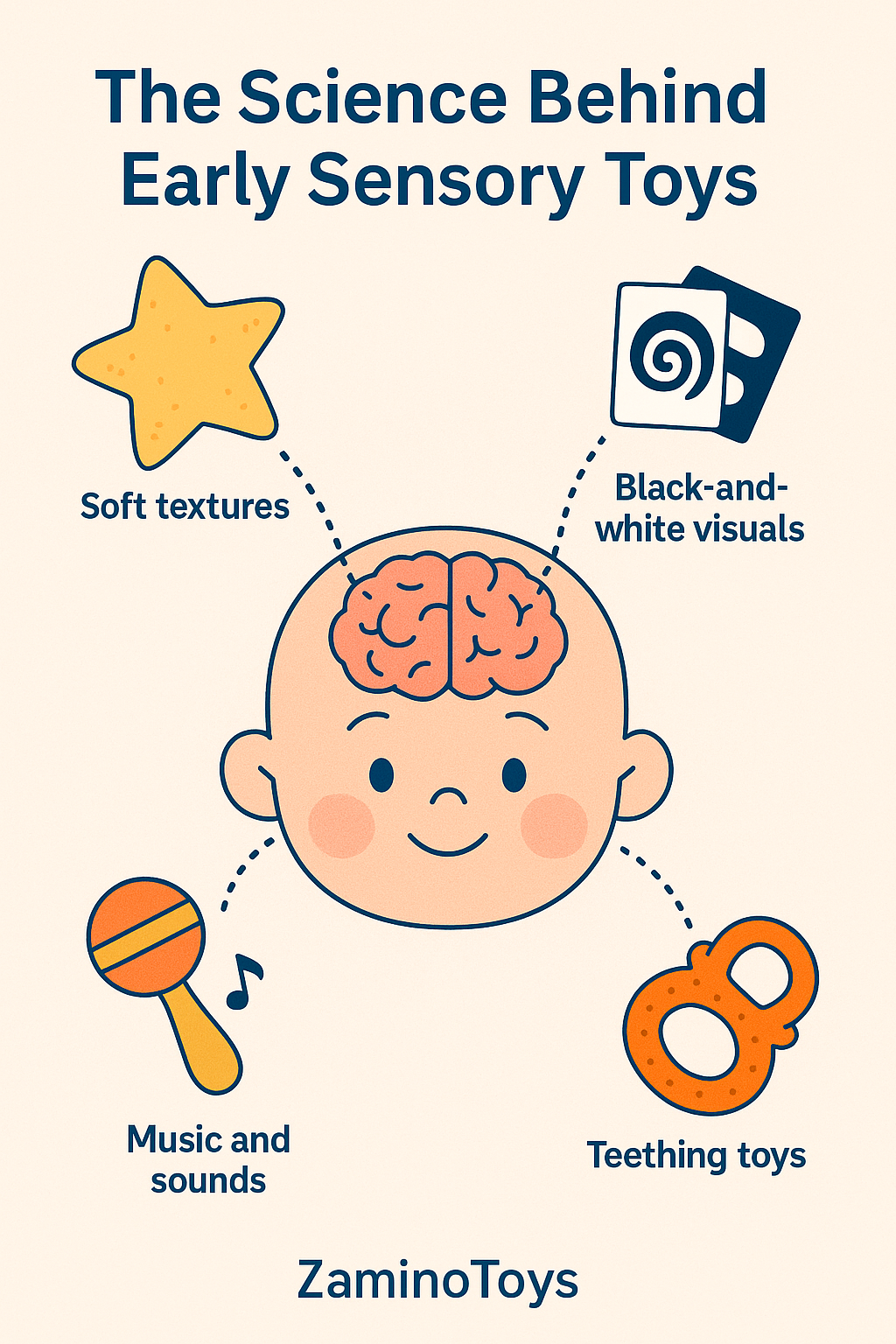
📖 UNICEF recommends daily sensory play to boost a child’s brain and emotional resilience.
👂 Hearing:
Use soft rattles, talking toys, or musical mobiles.
👀 Vision:
High-contrast black and white books improve focus.
🖐 Touch:
Fabrics with texture improve curiosity and motor coordination.
🤲 3–6 Months – Exploration & Action
Now your baby begins to reach, roll, and grab. Their neck is stronger. Their eyes follow movement. They are learning cause and effect — for example, “If I press, it squeaks!”
Now is an ideal occasion give them toys that they can play with.
🧸 Best Toys for 3–6 Months
✅ 1. Teething Toys
- Soothes sore gums
- Choose BPA-free silicone or textured rubber
- Chill in fridge (not freezer) for extra relief
✅ 2. Crinkle Books or Soft Books
- Make crinkle sounds when touched
- Encourage touch and visual exploration
- Introduce basic shapes, animals, or faces
✅ 3. Grasping Balls or Soft Blocks
- Improves hand-eye coordination
- Choose lightweight, easy-to-hold shapes
- Try activity cubes with tags and textures
✅ 4. Musical and Light Toys
- Introduce cause and effect
- Boost memory and attention
- Encourage movement and smiles!
✅ 5. Soft Animal Toys That Talk
- Toys that say “hello” or sing rhymes
- Improve language listening
- Build emotional bonding
💡 Real-Life Toy Tips for Indian Parents
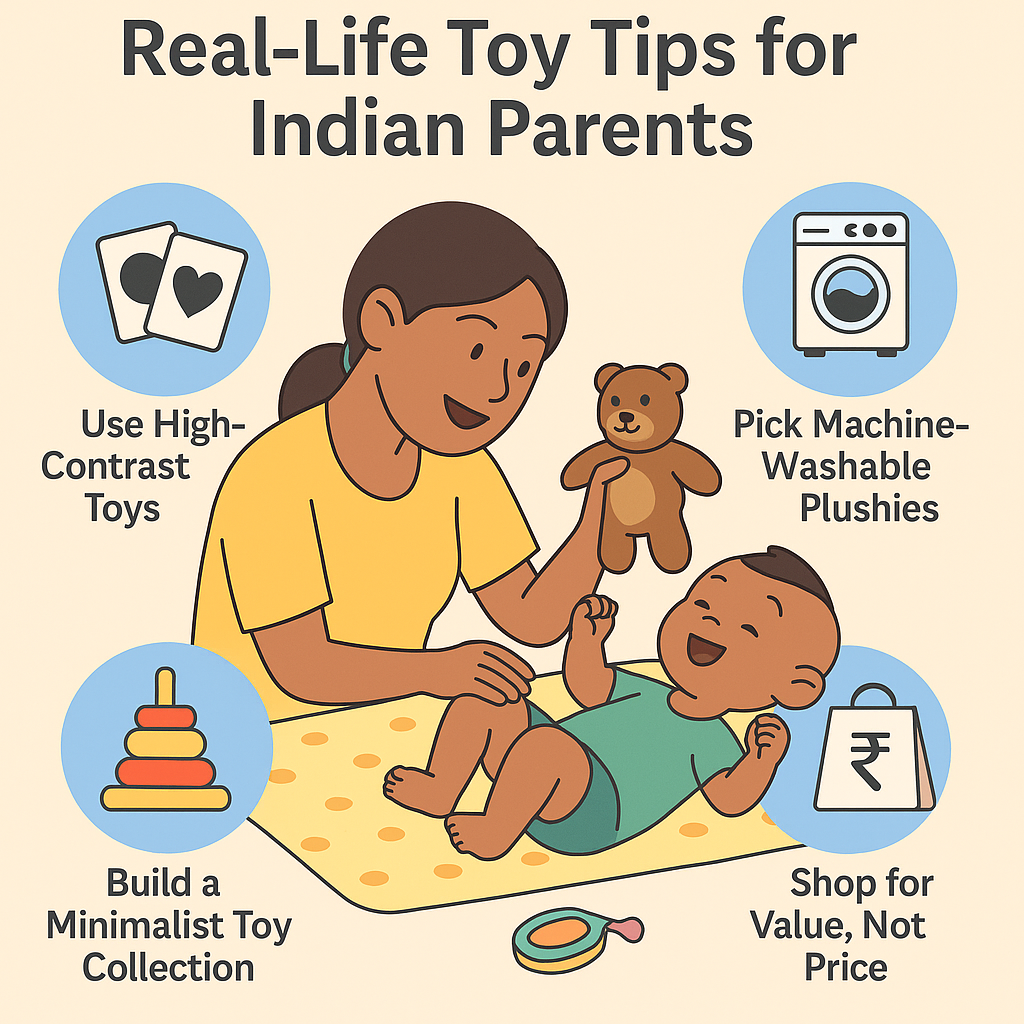
💰 Budget-Friendly Tips:
- Don’t buy too many toys. 5–7 quality toys per stage are enough.
- Use household items like scarves, steel cups, or old cloth for DIY toys (always supervise).
🧼 Hygiene Tips:
- Clean all toys once or twice a week.
- Wash soft toys with baby-safe detergent.
- Use toy sanitizer sprays for plastic toys.
🕒 Play Schedule Tips:
- Use morning time for active play
- Use bedtime for soft music toys
- Don’t force play when baby is tired or cranky
3–6 Months: Toys for Exploration
Your baby is now starting to move more — reaching, grasping, mouthing, rolling, and kicking. Their brain is learning fast, especially through cause-and-effect.
✅ What to Look For:
- Teething-safe toys made from food-grade silicone
- Crinkle or squeaky textures for sound discovery
- Toys that respond when touched (e.g. soft music, rattles)
- Graspable shapes that help with hand-eye coordination
🧠 Development Goal: Motor skills, cause-effect learning, coordination
🧩 Toy Examples:
- Soft blocks with different textures and sounds
- Silicone teething rings with textured grips
- Plush animals that talk or sing when squeezed
- Cloth books with lift-the-flap or crinkle pages
🛡️ General Toy Safety Checklist (For 0–6 Months)
Before giving any toy to your baby, run through this checklist:
| ✅ Must-Have | 🚫 Avoid |
| Age-labeled “0+” or “0–6M” | Small detachable parts |
| BPA-free, phthalate-free | Long strings or cords |
| EN71 / BIS certified | Sharp edges or zippers |
| Machine-washable (for soft toys) | Toys with button batteries |
| Lightweight and easy to grip | Overstimulating sound/light |
🔍 Always check toys daily for wear and tear, especially after teething or heavy mouthing.
🧰 Bonus Tip: Build a Minimalist Toy Kit
You don’t need 30 toys. You just need 6–8 purposeful toys that rotate weekly.
🛒 A balanced newborn toy kit might include:
- 1 high-contrast cloth book
- 2 soft rattles (different shapes/sounds)
- 1 musical mobile
- 1 baby-safe mirror
- 1 textured teether
- 1 plush toy for cuddling
- 1 tummy time mat or sensory play surface
This not only saves money but helps your baby focus better and feel less overwhelmed.
🧷 Toy Safety – What to Avoid
- ❌ Small parts that can be swallowed
- ❌ Long strings or cords (strangulation risk)
- ❌ Sharp edges or loose stitching
- ❌ Loud electronic toys
- ❌ Bright flashing lights
✅ Safety Checklist:
- BIS or ISI mark
- Non-toxic, BPA-free, phthalate-free
- Soft materials only
- Age-labeled “0–6 months”
Common Parent Questions
(FAQ)
Q1: Can newborns really use toys?
Yes, absolutely! Even if newborns can’t grip or interact with toys the way older babies do, they are constantly learning through observation, sound, and touch. Toys for this stage are all about stimulating the senses — especially vision and hearing.
For example, black-and-white sensory toys for newborns help babies strengthen their eyesight, while soft musical mobiles introduce them to patterns in sound and rhythm. A newborn doesn’t need to physically hold a toy for it to be effective — simply placing a toy in their line of sight or near their ears activates their brain.
👶 Tip: Hold a soft toy or rattle 8 to 12 inches away from your child’s face. You’ll notice them trying to focus or turn toward the sound — a big step in development!
Q2: What’s the best first toy for a 0–3-month-old?
The best first toys for newborns are those that stimulate visual, auditory, and tactile senses in a gentle and safe way.
- High-contrast black and white flashcards or books: These aid to improve eyesight and tracking abilities.
- Soft rattles: Lightweight and gentle-sounding toys promote early hearing awareness and grip reflex.
- Newborn plush toys or soft stuffed animals: Offer emotional comfort and bonding.
Avoid toys with lights, loud sounds, or hard plastic during this stage — babies need gentle, calming input.
Q3: Are homemade toys safe for infants?
Yes, homemade toys can be a beautiful and affordable way to engage your baby — as long as they are made with care and supervision.
Here are some tips for safe DIY toys:
- Use clean cotton fabric or fleece for soft balls and cuddly items.
- Pack rattles with grains or dried lentils wrapped in closed cloth (do not use plastic).
- Use textured cloth to create sensory squares for touch play.
- Avoid beads, threads, buttons, or anything small that can detach.
Always examine handcrafted toys for threads that are loose and damaged stitching.. Even the safest DIY toy needs parental supervision during play.
🎨 Bonus Tip: Create a “sensory basket” with baby-safe household items — like a soft scarf, silicone spoon, or crinkly paper — to add variety without cost.
Q4: How often should I change or rotate toys?
Changing toys regularly is one of the simplest ways to keep your baby engaged. You don’t need dozens of toys — rotating 4–6 toys every week can make old toys feel new again!
Here’s a smart routine:
- Use 2–3 toys per day and store the rest.
- Switch them every 5–7 days.
- Observe what your baby likes — and repeat that type of stimulation more often.
Rotating toys:
- Prevents overstimulation
- Keeps the play area tidy
- Encourages focus and curiosity
🚫 Avoid overwhelming your baby with too many toys at once — it can actually reduce attention span and interest.
Q5: Is screen time okay for babies under 6 months?
- Babies learn best from real human interaction, not screens.
- Screen exposure affects sleep, attention span, and bonding.
- Excess screen time in early months has been linked to delayed speech and social skills.
- Use talking toys
- Sing lullabies and rhymes
- Give soft musical toys or activity mats
- Engage in eye-to-eye conversation and facial expressions
🧠 How Toys Build Intelligence
Toys aren’t just for fun. They train your baby’s brain to:
- Solve problems – What happens when I shake this?
- Understand emotions – This plush toy feels safe
- Communicate – They mimic voices and learn sounds
- Develop focus – Crinkle books and visual toys boost attention span
According to Zero to Three, sensory play improves language, thinking, and social-emotional skills from as early as 3 months.
🧩Sensory Play Activities You Can Do at Home
- Mirror Time: While standing keep your infant in front of a mirror.
- Texture Basket: Use cloth, sponge, paper, fur
- Foot Painting: Dip baby’s feet in edible color
- Sound Discovery: Bang (lightly) on bowls
- Water Playing: Using warm water and floated toys (under adult supervision).
Final Thoughts : Let Play Be Your Baby’s First Teacher
In the first six months of your baby’s life, every moment is a stepping stone — a tiny, beautiful piece of the puzzle that forms your child’s future. And among the most powerful tools to support this journey are toys.
Toys are not just entertainment. They are silent educators, emotional anchors, and developmental partners. Every soft touch, jingling sound, and visual pattern helps your baby’s brain light up with curiosity and connection. Whether it’s a soft cuddly toy or a black-and-white flashcard, these early interactions support:
🧠 Brain Growth and Cognitive Development
Toys stimulate the senses, allowing the brain to form and strengthen neural pathways. This early brain architecture sets the foundation for learning, memory, attention, and reasoning.
🤗 Emotional Bonding
When your baby snuggles a plush toy or giggles at a musical rattle, they’re not just having fun — they’re building trust and comfort. These toys often become companions that soothe them and support their emotional well-being.
🗣️ Language and Communication
Talking toys, musical rhymes, and even your narration during playtime help your baby absorb new sounds and patterns — the first building blocks of language learning and social interaction.
💪 Motor Skill Development
From grasping soft rattles to reaching for light-up plushies, toys encourage babies to use and strengthen their little muscles. These easy exercises are essential for improving eye-hand coordination, strength of grip, and spatial cognition.💡 Confidence and Sensory Awareness
As babies explore textures, colors, lights, and sounds, they begin to understand how their actions affect the world around them. This builds confidence and early sensory intelligence.
But here’s the most important reminder for every parent and caregiver:
📝 You are your baby’s favorite toy.
Your voice, your touch, your smile — these are more powerful than any gadget or toy. Your presence during playtime fosters bonding, emotional security, and happiness.
So yes, choosing the right toys matters. But even more important is how you use them: lovingly, patiently, and consistently.
✅ Choose age-appropriate, safe, and sensory-rich toys.
✅ Create a daily play routine.
✅ Be present, even if just for 10–15 minutes of focused play.
Remember, every giggle, grip, gaze, and grab is your baby learning something new.
📌 Explore more parenting insights, toy tips, and stage-by-stage play guides at ZaminoToys.in
🔗 Related Blogs:
- Toys – What, When & Why? A Complete Guide for Parents
- Age-Wise Toy Guide: Choose the Right Toy by Age

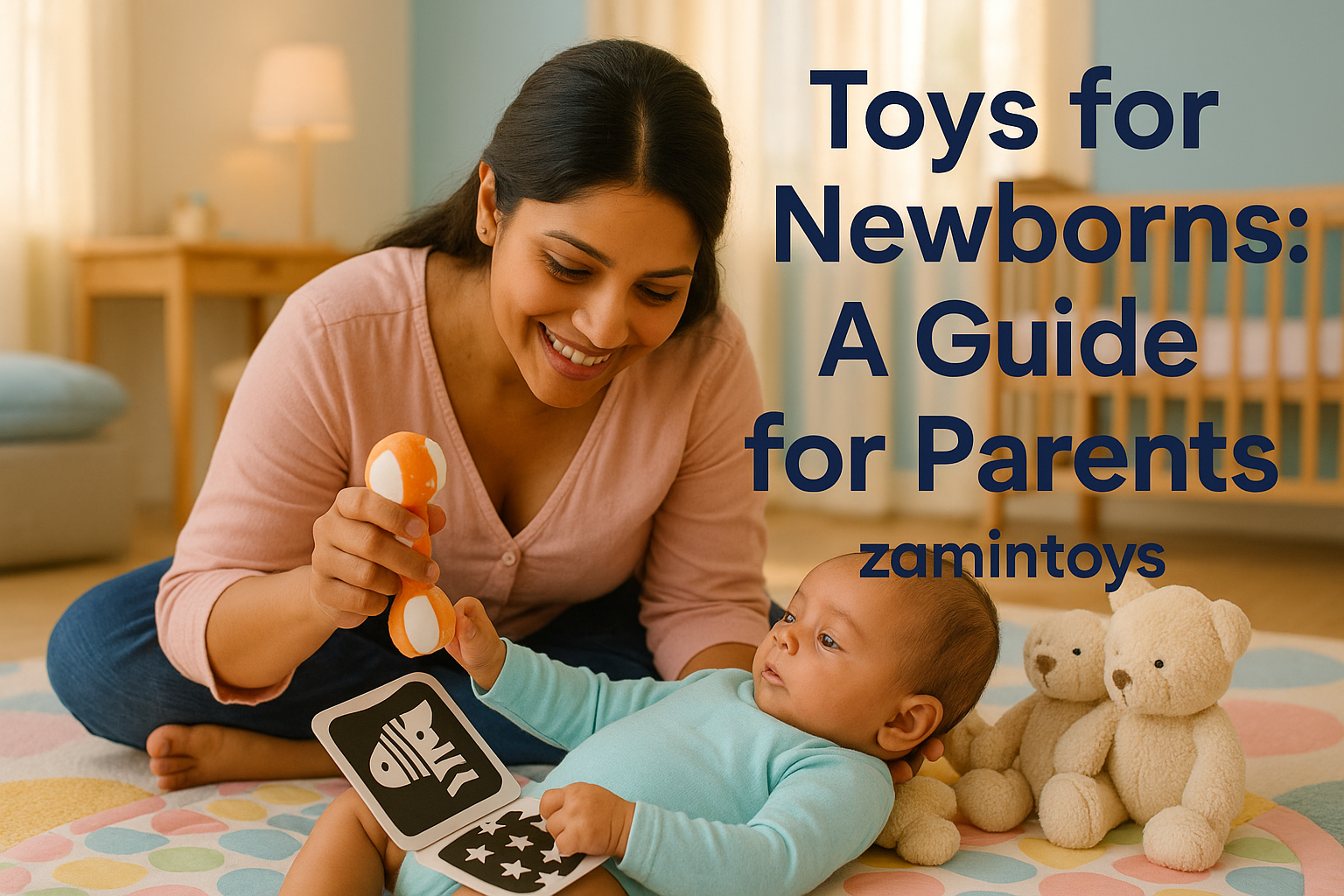
Pingback: 5 Gentle Parenting Tips That Work – Indian Parenting Advice
Pingback: Best Toys for 6 to 12 Months – Montessori & Milestone Play
Pingback: Brilliant DIY Sensory Toys at Home for Babies (0–12 Months